Kyoto cuisine
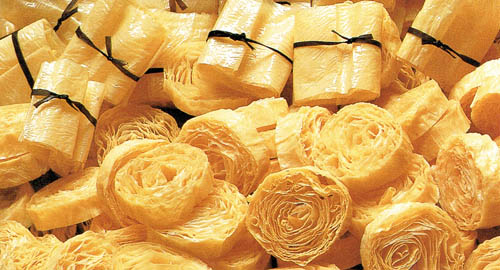
An elegant banquet for a nobleman, a tea master's meticulous repast, the bare sustenance of a Zen priest, morsels to whet the appetite of a carousing samurai, simple fare for the working man - Kyo-ryori, or Kyoto cuisine, is an intriguing blend of a thousand years of history with as many exotic ingredients, from fresh fern greens to pickled herring to yuba.
Yuba is perhaps the quintessential Kyoto ingredient. Skimmed from open vats of steaming soy milk, yuba is served fresh with a light sauce, or dried in strips or rolls to be used later in soups and a variety of inventive ways. Almost pure protein, yuba is an important ingredient in Zen vegetarian cooking (as is fu, its glutinous wheat counterpart). The flavor is subtle, and indescribable; the texture, delicate. Yuba is a backdrop against which other ingredients play - the blank space that defines the culinary lines, a master's touch to a cuisine that is truly an art.
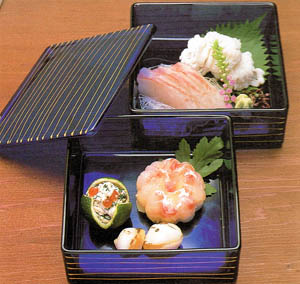
The fusuma door slides open ... s-s-s-h-u-s-h. A maid kneels outside, bows, apologizes for the intrusion. You are seated on a pillow in a tatami room overlooking a garden. The sound of water trickling into a stone basin outside has helped to wash away the day's frustrations.
You have been sitting here, sipping the green tea, eating the small sweet that has gently awakened your appetite, exactly as it was intended. The first lacquered try of morsels appears just in time.
Kaiseki promises you'll never be bored. The meal you are served depends on the precise time of year. The best chefs guarantee their guests will never receive the same meal twice. In Kyoto, a meal is to be savored by more than the palate.
There is atmosphere in which to lavish, scenery to enjoy. There are gilt-edged bowls and inlaid-lacquer boxes whose craftsmanship, design, and color may also be imbibed. There are aromas brought one at a time to tantalize an appetite for the dish that follows.
Kaiseki was designed to please emperors. It was refined and perfected by tea masters with a preference for simplicity and meticulous attention to the seasons. The Chinese characters (ë¨É╬üjrefer to the heated stones carried to bed inside the folds of the kimono of Zen monks, just enough to take the chill from their bellies. In the later centuries, kaiseki, written with less aesthetic characters (ë´É╚), became hors d'oeuvres served with sake for the merchant class out for a night of pleasure in the geisha houses of Gion.
No matter what the occasion, Kyoto-style kaiseki places importance on seasonal ingredients, whose flavor is to be enhanced gently, never to be overwhelmed by heavy spices or elaborate sauces. It is intended to be served graciously, enjoyed leisurely, and appreciated attentively. (Today, a kaiseki meal can be extremely costly, but it is an experience that does not have to be missed. For a person on a limited budget, a kaiseki bento, the "box lunch" supreme, will provide a delightful sampler of this magnificent cuisine.)
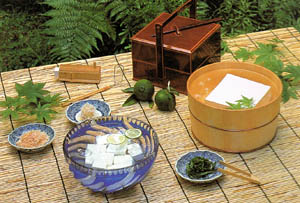
But Kyoto was more than aristocrats and playboys. The vast majority of people were farmers, shopkeepers, and craftsmen who never got near a kaiseki meal. Kyoto was a landlocked city, a two-day trek over the mountains to the sea. Fish had to be salted or pickled to be carried that far on foot by peddlers. Even vegetables had to be pickled to save them from perishing in the hot, sticky summers.
The people's cuisine of Kyoto was far from exotic. A bowl of barley rice, a few pickled vegetables, a bowl of miso soup - a bite of fish when times were good - and a cup of the plainest tea; humble fare, often vegetarian, as much of the population was Buddhist.
Shojin-ryori, Zen-style cooking, served in temples and vegetarian restaurants today, turned the simple sustenance of Buddhist priests - vegetables, rice, and soybeans - into a creative and interesting cuisine that is apparent in every aspect of Japanese cooking.
The cuisine that the painstaking monks evolved explored every imaginable use of its simple ingredients, especially of soybeans - a hundred ways to serve miso, soy sauce, tofu, and yuba, all rich in protein.
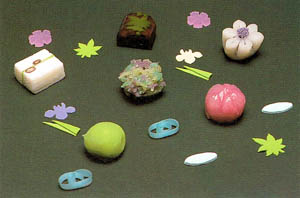
The same attention to visual beauty that other forms of Kyo-ryori possess is found in shojin-ryori, though not to such a lavish degree. Nothing should be wasted, and rather than costly porcelain, the monks each had their own stack of bowls, one fitting inside the other, wiped clean by the monk himself when the meal had been thankfully consumed.
The dimensions of Kyoto cuisine reflect the seasons and sensibilities of all the townspeople - from priest to bon vivant, from nobility to peasants.
Source Notes
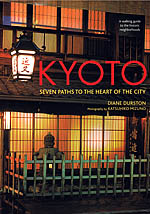
Reprinted with permission from the book:
Kyoto: Seven Paths to the Heart of the City
Kodansha International
American writer and former Kyoto resident Diane Durston introduces seven must-see precincts of this ancient capital city, including four Historic Preservation Districts. Among them are the world-famous geisha quarter, the kimono textile neighborhoods, the sake-brewing area of Fushimi, and the tea-growing region of Uji. Durston weaves together local lore and historical sites to create a panoply of provocative walking tours that take the reader back in time to the elegance of earlier days.
Accompanying each section is a full-color map and the fine photography of Katsuhiko Mizuno, a Kyoto native and one of the city's most famous photographers. Sections highlighting Kyoto crafts, cuisine, festivals, and tourist essentials round out this attractive volume, making it the perfect introduction - and guide - to one of the world's most evocative cities.
ISBN 978-4-7700-2877-8
Y2940
- Order this book from amazon.com
- Order this book from amazon.co.jp (in Japan)
- Find this book at your local English-language bookstore in Japan
- Or use the ISBN to order from your local bookstore.
More articles
- © Copyright Lobster Enterprises
- Privacy
- Bento.com top
- © Copyright Lobster Enterprises
- Privacy
- Bento.com top
- © Copyright Lobster Enterprises
- Privacy
- Bento.com top







